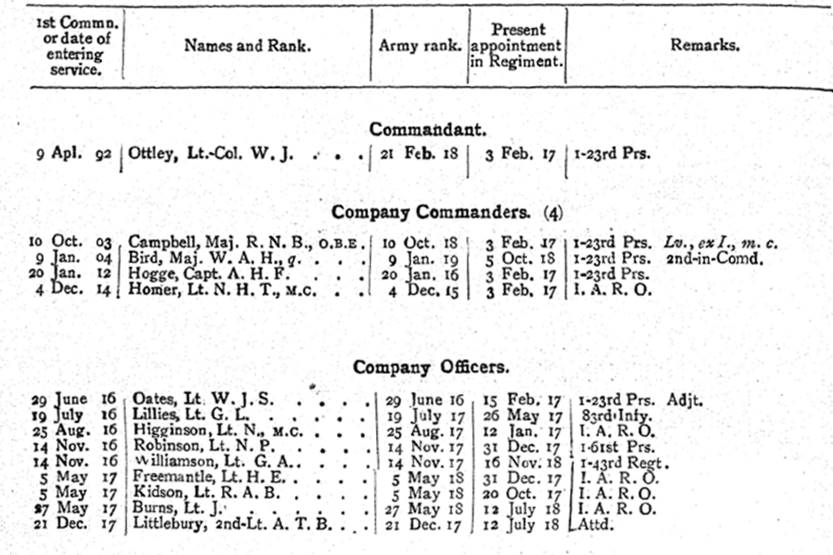This article is about the war-raised 2nd Battalion 23rd Sikh Pioneers and will help you to research the Battalion and the soldiers who served with it during the First World War. I’ve written separate articles for the 1st and 3rd Battalions and a series of guides to help you research soldiers who served in the Indian Army. To view the guides click on the blue links below:
- 1st Battalion 23rd Sikh Pioneers
- 3rd Battalion 23rd Sikh Pioneers
- Researching Soldiers who served in the Indian Army
The 2nd Battalion 23rd Sikh Pioneers in the First World War
Lineage: The 2nd Battalion 23rd Sikh Pioneers was formed at Shallufa, Egypt on 3 February 1917 and became the 10th Battalion 3rd Sikh Pioneers (a training battalion) on 1 April 1922. For a history of the Regiment’s lineage see my page on the 1st Battalion 23rd Sikh Pioneers.
Class Composition of Battalion in 1919: 4 Companies of Mazbi and Ramdasia Sikhs.
The 2nd Battalion 23rd Sikh Pioneers was the first of two battalions raised by the 23rd Sikh Pioneers during the First World War. The 2nd Battalion was formed at Shallufa, Egypt on 3 February 1917 from half the 1st Battalion and a large draft of pioneers recently arrived from India. The regimental history (see below) The History of The Sikh Pioneers by Lieut-General Sir George MacMunn contains a letter from Lieutenant-Colonel W. J. Ottley on page 488 describing the formation of the Battalion in detail. The Battalion joined the 75th Division as Divisional Troops and served with it for the duration of the war. The Battalion returned to India in February 1919 and was stationed at Chaman, Baluchistan (Balochistan, Pakistan) when the Third Anglo-Afghan War broke out in May 1919. The Battalion served with the 4th (Quetta) Division during the war and on 1 April 1922 became the 10th Battalion 3rd Sikh Pioneers. This was the 3rd Sikh Pioneers’ Training Battalion. The extract below was taken from the April 1919 Indian Army List and recorded the British officers serving with the Battalion.
War Diaries of the 2nd Battalion 23rd Sikh Pioneers
There are two war diaries for the 2nd Battalion 23rd Sikh Pioneers but neither have been digitized and can only be viewed at the National Archives. I have transcribed some entries from the second war diary below.
- Date: 01 August 1917 – 31 December 1918
- 75th Division, General Headquarters Troops
- Reference: WO 95/4410
- Notes:
- Date: 09 May – 17 December 1919
- 4th (Quetta) Division, Baluchistan Force
- Reference: WO 95/5412
- Notes: A good detailed war diary, though after November very little occurred. There is a list of British officers with the 2nd Battalion 23rd Sikh Pioneers when they left Ambala on 9 May 1919.
Further Sources for the 2nd Battalion 23rd Sikh Pioneers
For information concerning the British and Indian officers who served with the 2nd Battalion 23rd Sikh Pioneers, the Indian Army List can be consulted. There is a single confidential report for the Battalion which also contains the confidential reports of the British officers serving with it: Confidential review reports on Indian Army units, depots, British officers, etc. for 1919-1920: IOR/L/MIL/7/1703. There is also a regimental history The History of The Sikh Pioneers by Lieut-General Sir George MacMunn which can be viewed for free online by clicking on the blue link below:
The History of The Sikh Pioneers
Extracts from War Diaries of the 2nd Battalion 23rd Sikh Pioneers
09 May – 31 December 1919, Baluchistan Force, WO 95/5412
12 May 1919 – Killa Abdullah – Arrived Quetta and received orders to proceed to Killa Abdullah by rail at once. On arrival Killa Abdulla kit had to be manhandled about 1/2 mile to campsite owing to shortage of transport.
28 May 1919 – Shelabagh – B Company employed on pipeline. C and D Companies on making a crossing place on the new Chaman Road at mile 61 1/4.
02 June 1919 – Chaman – Camel transport with escort of 3 platoons under Lieutenant R.A.F. Kidson marched from camp at 07.30 hours. The remainder of the Battalion marched at 09.00 hours by the old road. Great difficulty was experienced with camels on the down gradients [?] towards Chaman after crossing the Khojak Range, owing to pioneer loads not being suited to camels. The Battalion halted at Old Chaman to allow transport to reform on the level and get ahead again. Distance from Shela Bagh to New Chaman is about 17 miles, very hot weather and no breeze. On arrival in camp there were two cases of heat stroke among the Indian ranks.
24 June 1919 – Chaman – Scouts located party of about 40 armed villagers on British side of border and 10 more in sangar on top of hill near border. Scouts retired to camp and enemy parties were kept under observation from Chona.
2nd Lieutenant Downing was transferred to C.F.A. on 23rd instant and on arrival in Chaman it was found that he was suffering from “anthrax” contracted from a shaving brush manufactured in Japan. He was operated on 23rd instant. [Well worth reading https://www.fuzzjunket.com/he-got-anthrax-off-his-shaving-brush/]
Guides to Researching Soldiers who Served in the Indian Army
Guides to Researching Soldiers who Served in the British Army

